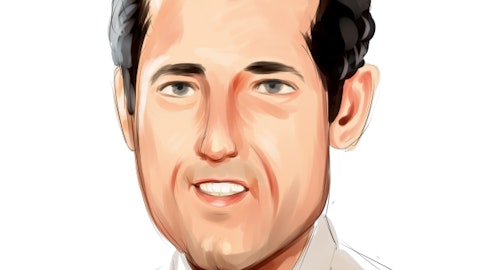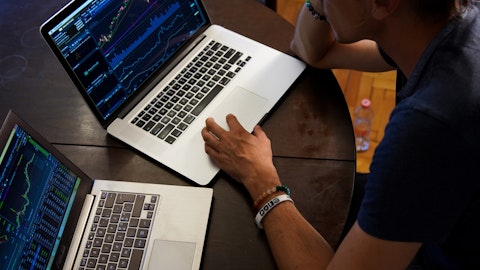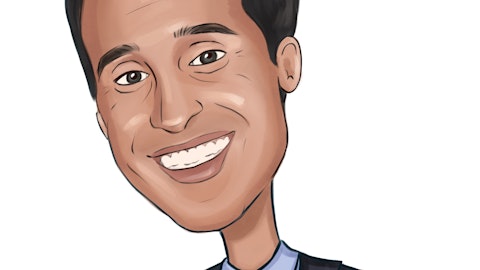Bobby Griffin: Good morning, guys. Thank you for taking my questions. Scott, in your prepared remarks, you talked a little bit about an opportunity to sell some products maybe or some retailers that don’t have as much share, I think you guys do have a test going on with Sam’s with maybe some potential to launch that in store. So, can you maybe update us on how that initial rollout is going and some of the timing around that? And is anything assumed in the guidance for picking up some new swap placements there?
Scott Thompson: Yes, we are in Sam’s online. You can see us online. And we’re working very closely with Sam’s and other customers to fill their needs. I don’t really have an update for you and we generally don’t talk a lot about specific individual customers, but I would say our relationship with Sam’s is good and expanding. Do we have anything specific in our guidance? No. I would say that we have lots of opportunities and sales team have goals, but we certainly don’t start putting that, kind of step in a forecast until we would have a firm deal.
Operator: Thank you. And our next question coming from the line of Atul Maheswari from UBS. Your line is open.
Atul Maheswari: Good morning. Thanks a lot for taking my question and thanks for all the great color on the call. Starting, Bhaskar, a question on the sales guidance. So, up 5% or rather up mid-single-digits, if there were a scenario wherein sales were to fall short, say, sales were flattish or low single digits, do you have enough cushion in the P&L to maybe pair back on expenses which still achieve the EPS guidance of ?
Scott Thompson: Well, there’s really €“ there’s embedded quite a bit in that question. When you know our variable cost structure, which we have, Bhaskar and the variable cost structure
Bhaskar Rao: .
Scott Thompson: . So, we have the ability to call it right-size the organization relatively quickly if there’s a downturn. I think the real issue though is, would you pull all those levers, you certainly would pull levers if you thought you were headed towards several quarters of recessionary activity. You may or may not pull the levers though, if you think you’ve got a very short-term downturn in business because within the organization around is complicated and you might take as an opportunity not to pull those levers. So, I can’t guarantee what we would do. I think it might be interesting to know that as an example in 2022, if you look at our advertising expenses, our advertising expenses in North America on a dollar basis is up and obviously as a percentage because our sales are down is up.
And you might wonder why didn’t we pull that lever? We could have pulled the lever and pulled back on advertising in the latter part of 2022. It had a higher EPS number and maybe make somebody happy on the street. I don’t know, but we run the business for the long-term. And we’ve taken the opportunity to continue to support our brands. So, it’s a great business model, so we have the flexibility to deal with those situations. But right now, we’re in a pretty strong competitive position. And my guess is, we’re talking about short-term little bit of in the overall macro market. I suspect we’ll continue to be aggressive, take share, and support our brands.
Operator: Thank you. And our next question coming from the line of Peter Keith with Piper Sandler. Your line is open.
Unidentified Analyst: This is on for Peter. Thank for taking my question. Sorry, if I missed it, but can you just walk us through the puts and takes of your input costs this year? I know you said it’s expected to be down, but just can you go through maybe on, kind of individual basis, how you’re expecting 2019 and what’s embedded in the guidance? Thanks.
Bhaskar Rao: Yes, absolutely. So, when I think about commodities, as I mentioned on the call, I think about everything from ocean cargo to raw material to labor. So, broadly speaking, we’ve seen unprecedented increases in commodities over the last few years. So, the way I think about 2023 and what we saw in the fourth quarter 2022 a bit, is that they have come off their peaks and the peaks being earlier in the year. But what I would say is that we are expecting, let’s call it, a modest tailwind into 2023, however, by no means are they at the pre-pandemic level.
Operator: Thank you. One moment for our next question. And our next question coming from the line of Jonathan Matuszewski from Jefferies. Your line is open.
Jonathan Matuszewski: Great. Thanks so much for taking my question. I had a question on the competitive landscape. Your largest competitor recently filed for bankruptcy a couple of weeks ago. Just curious if you could give us a sense of how conversations with your retail partners have looked since this news broke and how are conversations progressing regarding potential slot gains for the TSI brand? Thanks so much.
Scott Thompson: Yes. Thanks for the question. Look, I don’t think that particular news was shocking to the industry, I think it was well telegraphed and expected. So, I don’t think it’s fundamentally changed the discussions with our retailers. What the retailers care about is quality products, support with advertising and those kind of items. I think our chief competitor has strong brands and is a hard, tough competitor. But we continue to work aggressively with our retailers. So, I don’t think the actual filing changed very much in most retailers mines, as long as they provide quality products and service in the marketplace.
Operator: Thank you. And our next question coming from the line of Brad Thomas with Keybanc. Your line is open.
Brad Thomas: Hi, thanks. Scott, I was hoping to ask about the international product changes that are underway. Obviously, the potential will be really, really substantial for the company. I was hoping you could share a little bit more detail on perhaps how much this expands the addressable market for Tempur and how you think about what the financial impact could be once this is rolled out? Thanks.
Scott Thompson: Yes. I’ll start, and I’ll let Bhaskar probably clean me up. As you said, look this is a significant launch internationally, bigger than a normal Tempur launch as we’re repositioning the brand and we’re changing some of the manufacturing procedures as to how we make temper so that we can hit some lower price points and serve our customers better. Early on, we’re in the middle of it. Early indications are good. And I’d say, what’s the addressable market expansion do you think, is it 20% 30%, 20%, 30% absolutely from an addressable market standpoint, of course, we have to perform. You can’t just put that and say, okay, that’s going to increase Tempur sales that much, but we’re working very hard on the area, but I do think it unlocks a growth potential for the international operations.
From a sales standpoint, we should start seeing that in the second quarter of this year. Because of the launch cost and stuff, you’ll see the benefits of EBITDA probably starting in 2024 and the full benefit of it. But I think long-term over the next two or three years will be very important from our growth standpoint.
Operator: Thank you. And our next question coming from the line of Laura Champine with Loop Capital. Your line is open.
Laura Champine: Thanks for taking our question this morning. It’s on the, kind of inputs to the guide for mid-single-digit growth this year. Does the industry need to recover in the back half and actually be positive in the back half in your view for you to hit that estimate?





